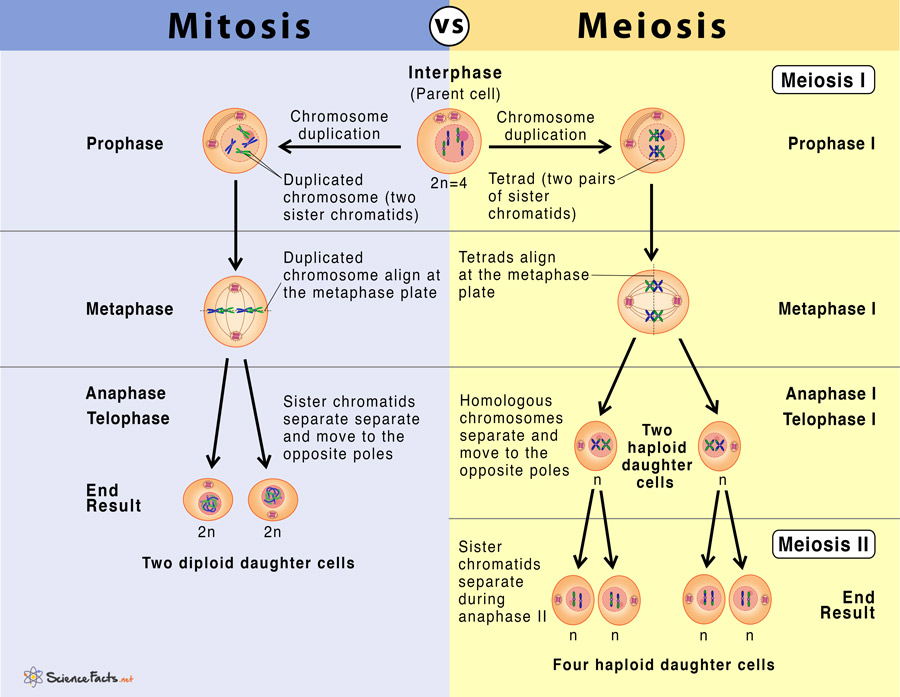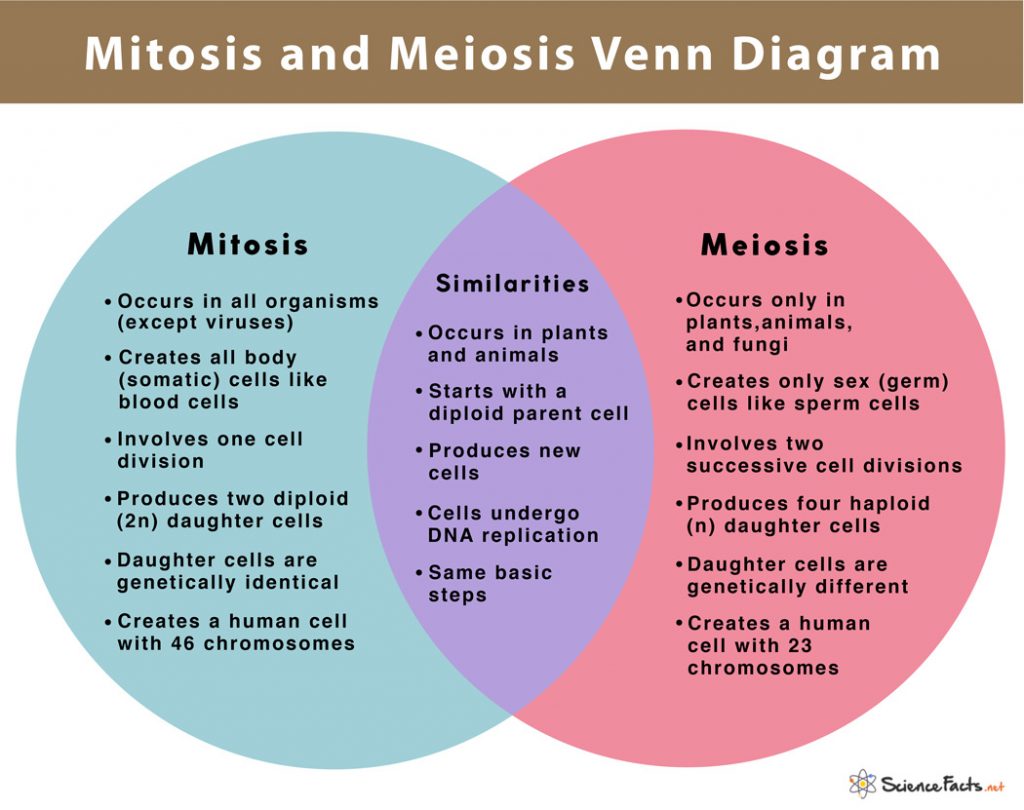Comprehensive Reading Worksheets on Mitosis and Meiosis Phases
The primary goal of all living organisms on earth is to reproduce in gild to survive and evolve, generation subsequently generation. In multi-celled organisms (eukaryotes), the cells grow and reproduce using two different prison cell division processes — mitosis and meiosis.

What are Mitosis and Meiosis
Mitosis is the process by which somatic cells duplicate and divide their genetic textile, forming two identical daughter cells. Meiosis, on the other hand, allows reproductive cells to split up twice to produce four not-identical daughter cells, each having one-half the genetic textile of the parent prison cell. The quondam is used in eukaryotes mainly for cell growth and repair, while the latter is necessary for reproduction.
Compare and Contrast between Mitosis and Meiosis
Although both are similar in some ways, there are also many differences in their basic processes, steps, and the outcome. The important ones are listed below.

What is the difference between Mitosis and Meiosis
| Basis | Mitosis | Meiosis |
|---|---|---|
| one. Terminate Result | Produces two daughter cells. | Produces four daughter cells |
| 2. Chromosome Number | The daughter cells are diploid (2n). | The girl cells are haploid (n). |
| 3. Genetic Composition | Daughter cells are genetically identical. | Daughter cells are genetically different. |
| 4. Primary Purpose | a) Growth, repair, and replacement of old, damaged cells in college organisms; a form of asexual reproduction in lower organisms (prokaryotes). b) Not involved in maintaining the chromosome number in organisms. c) Helps in cell multiplication during the early menstruation of growth. | a) Formation of sex cells or gametes, necessary for reproduction in college organisms. b) Maintains the chromosome number in the organism. c) Helps to maintain genetic diversity in the population. |
| 5. Takes place in | All organisms except viruses. | Only in animals, plants, and fungi. |
| 6. Number of Cell divisions | Involves 1 cell division. Steps: Prophase, Metaphase, Anaphase, Telophase. | Involves two prison cell divisions. Steps: (Meiosis 1) – Prophase I, Metaphase I, Anaphase I, Telophase I; (Meiosis 2) Prophase Ii, Metaphase Two, Anaphase II, and Telophase II. |
| vii. Cells it Produces | Creates all trunk (somatic) cells such every bit claret, liver, and peel cells except the germ cells. | Creates sex (germ) cells — eggs and sperms. |
| 8. Length of Prophase | Prophase is shorter than prophase I in meiosis. | Prophase I is longer than the prophase of mitosis. |
| 9. Formation of Synapsis and Crossing Over | Both are absent. | Both take place during prophase I. |
| 10. Formation of Tetrad | Absent | Occurs during prophase I. |
| xi. Number of Chromatids and Centromere | Each chromosome contains two chromatids and a single centromere. | Each chromosome contains iv chromatids and two centromeres. |
| 12. Chromosome Alignment | Sister chromatids align forth the center of the cell during metaphase. | Sister chromatids align along the middle of the cell during metaphase I. |
| 13. Chromosome Separation | Sister chromatids separate during anaphase. | Sister chromatids do non separate during anaphase I. |
| 14. Cytokinesis | Occurs one time at the end of telophase. | Occurs twice at the stop of telophase I and telophase II. |
How are Mitosis and Meiosis Like
- Start with a diploid parent cell.
- Are preceded by an initial growth menstruation called interphase of the cell cycle, during which the Dna is duplicated. Thus the number of chromosomal duplication is the same in both the processes.
- Go through the aforementioned basic phases; prophase, metaphase, anaphase, and telophase.
- Involve lining the duplicated chromosome (sister chromatids) along the center of the cell during the metaphase.
- Involve separation of sister chromatids forming daughter chromosomes during anaphase of mitosis and meiosis II
- Stop with the division of cytoplasm chosen the cytokinesis that produces new cells.
Conclusion
Considering the differences and the similarities, the basic significance of mitosis and meiosis is that they both involve cells to divide and form new cells. This makes them vital for the survival of organisms that reproduce sexually.
FAQs
Q1. Who discovered mitosis and meiosis?
Ans. Walther Flemming discovered the process of mitosis in 1879, while meiosis was discovered past Oscar Hertwig in 1876.
Q2. Practice prokaryotes undergo mitosis?
Ans. Cell division in prokaryotes does non occur through mitosis just undergoes a similar process known equally binary fission.
Q3. Which of the 2 processes occurs more frequently?
Ans. Mitosis is the more common of the two processes in all living cells since information technology helps grow, repair, and replace the sometime and damaged cells. In contrast, meiosis occurs only in reproductive cells during the germination of gametes.
Q4. What is evaluated at the G2 checkpoint in mitosis and meiosis?
Ans. At the G2 checkpoint in both, it is evaluated whether any Dna is damaged in the cell to make up one's mind whether the prison cell should progress further in the jail cell cycle.
Q5. Why do some species employ both mitosis and meiosis?
Ans. Some species utilise both mitosis and meiosis because the one-time helps in the initial growth of the organism while the later is needed in carrying out their reproduction.
Q6. When is DNA replicated in mitosis and meiosis?
Ans. Deoxyribonucleic acid is replicated during the S phase of interphase earlier the starting time of both mitosis and meiosis.
Q7. Why is meiosis ameliorate than mitosis?
Ans. Although both are essential in higher organisms, meiosis has an advantage over mitosis in that the former helps create genetic variation within the population such that every individual is different from the other.
Q8. What do spindle fibers do during mitosis and meiosis?
Ans. Spindle fibers aid divide the DNA of the parent cell equally among the two resulting daughter cells both during mitosis and meiosis.
-
References
Commodity was last reviewed on Tuesday, November 3, 2020
Source: https://www.sciencefacts.net/mitosis-vs-meiosis.html
0 Response to "Comprehensive Reading Worksheets on Mitosis and Meiosis Phases"
Postar um comentário